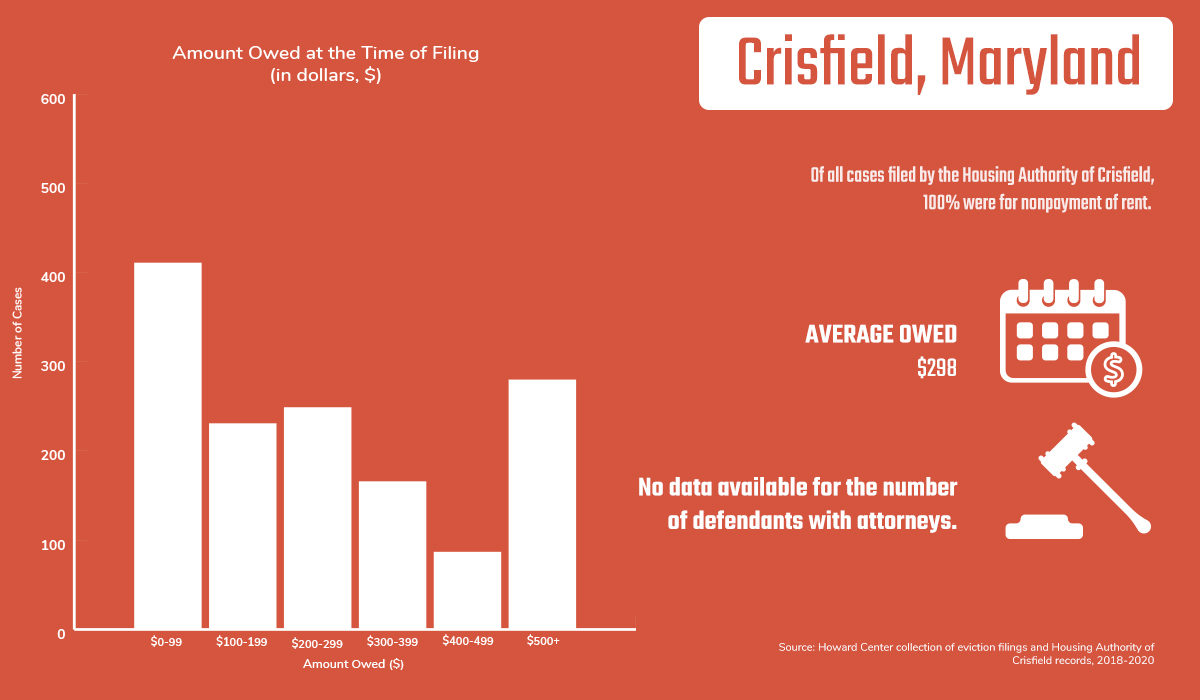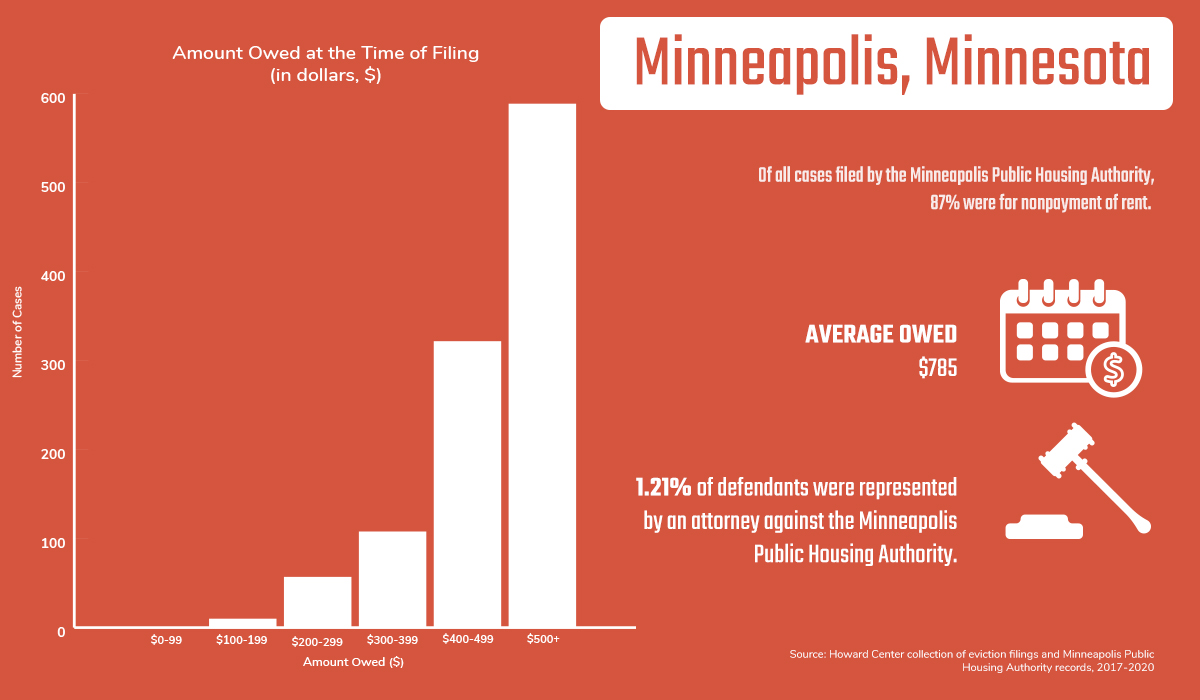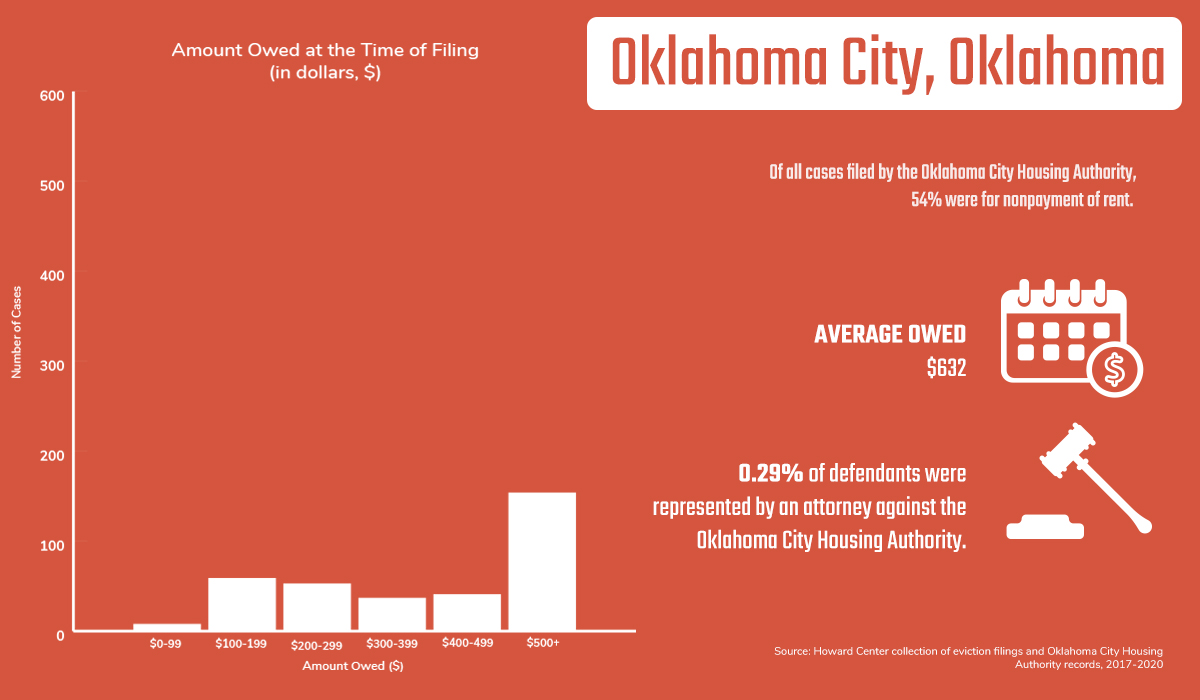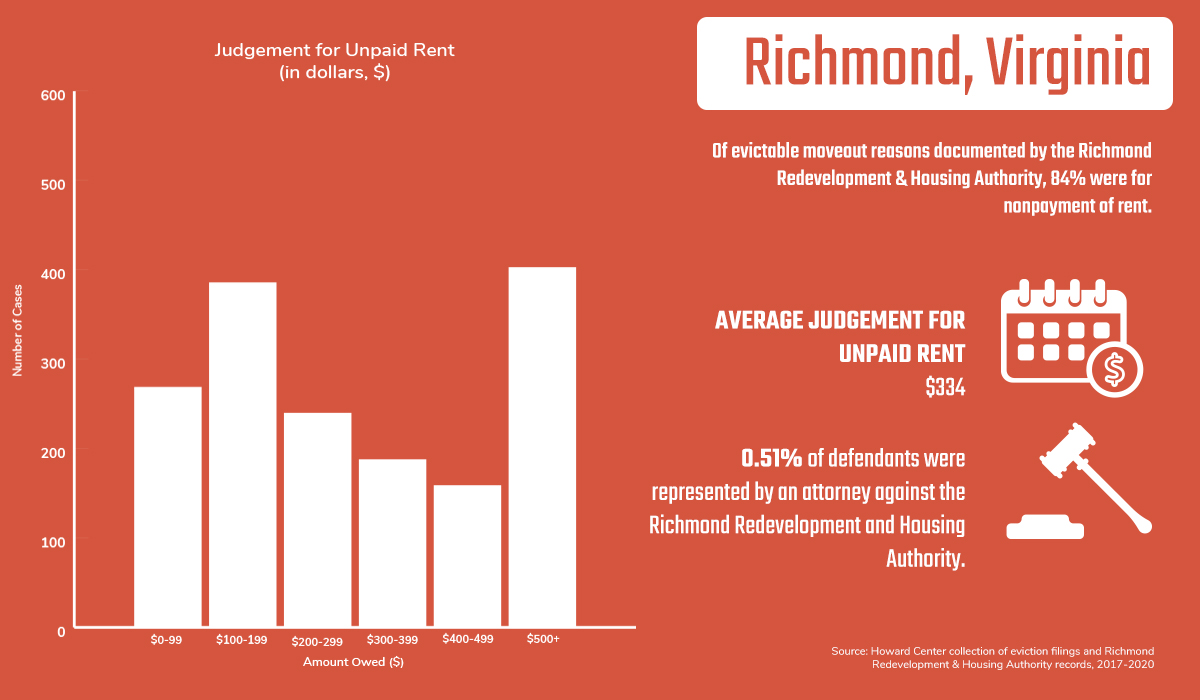By Bryan Gallion, Maya Pottiger, Kara Newhouse, Ryan Little, Trisha Ahmed, Jenna Pierson, Anastazja Kolodziej and Allison Mollenkamp
Published December 18, 2020
CRISFIELD, Md. — Public housing is supposed to be a solution to homelessness, not a cause of it.
But in Crisfield, a city of 2,600 on the Chesapeake Bay, the housing authority is one of the leading eviction filers. It takes so many tenants to court that officials hired a contractor to automate the process.
The agency owns just 330 units yet filed 718 times in 2019, all over late rent. In nearly 30% of those cases, records show, tenants owed less than $100.
What’s happening here isn’t an anomaly.
Reporting from Crisfield, Maryland, by Trisha Ahmed, Jenna Pierson and Kara Newhouse; from Richmond, Virginia, by Anastazja Kolodziej and Allison Mollenkamp; on Charleston, South Carolina, by Julia Lerner and Luciana Perez Uribe Guinassi; on Oklahoma City by Bryan Gallion and Clara Longo De Freitas; on Minneapolis by Bryan Gallion; on eviction alternatives by Aneurin Canham-Clyne and Brogan Gerhart.
Data analysis by Maya Pottiger, Ryan Little, Nick McMillan, Rina Torchinsky and Philip Van Slooten. Photography by Nick McMillan. Site design by Sean McGoey and Camila Velloso. Graphics by Jenna Cohen, Amina Lampkin, Maya Pottiger, Rina Torchinsky and Philip Van Slooten. Social media by Camryn DeLuca and Maya Koeppen.
This story was written by Bryan Gallion and Kara Newhouse.
The Howard Center for Investigative Journalism analyzed four years of eviction data for Crisfield and four other public-housing authorities with aggressive filing records — in Minneapolis; Oklahoma City; Charleston, South Carolina; and Richmond, Virginia — to find out why these important anti-poverty agencies are taking so many of their clients to court.
Late rent payments were by far the leading reason they sought to evict their tenants, who are living in public housing because they’re struggling to make ends meet.
Those filings far exceeded evictions over criminal activity, which have received much more public attention. In some cases, the sums were so small that it cost the agency more to file the case than was owed.
Public housing is “meant to accommodate people who are having difficulty paying their rent, because they have very limited incomes to begin with,” said Diane Yentel, the president and CEO of the National Low Income Housing Coalition. “They’re seniors, they’re people with disabilities, or they are working people, working families who are working very low-wage jobs that are often unpredictable.”
But the program has been underfunded by Congress for decades, leading some housing authorities to adopt unyielding approaches to rent collection so they can sustain their operations. Some housing officials say filing for eviction is the only way they can hold their tenants accountable.
“If you owe a dollar, you owe a dollar,” said Don Bibb, executive director of Crisfield’s housing authority.
Yet for the tenants, many of them single parents with young children, it’s not that simple. The near-constant threat of eviction makes it even more difficult to find their footing.
In Crisfield, Tawna Thomas, 26, said she cobbled together the cash to stave off court proceedings for her first eviction filing in March 2018 — not long after losing a pregnancy and a job. But that didn’t solve the bigger problem.
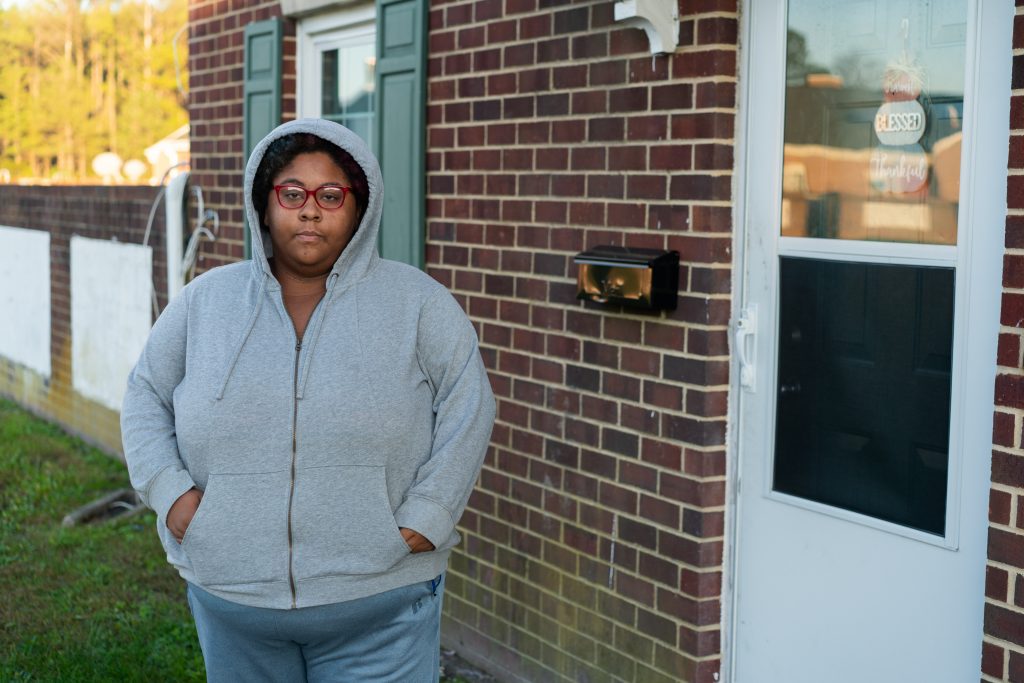
Each turn of the calendar brought fresh worries about how to pay her $138 rent, she said. Thomas, the mother of a 5-year-old, received five eviction filings in an 18-month period, according to court records. Although she hasn’t been served an eviction notice so far in 2020, she said she worries that day is coming. Especially when the sheriff’s vehicle rolls up.
“My heart starts fluttering every time,” Thomas said. “I’m just like, ‘What if he pulls up to my house? What if he has a paper for me? How am I gonna pay this?’”
Federal and state restrictions during the pandemic have temporarily slowed the pace of rent-related eviction filings, records show, but haven’t halted them. They place the onus on tenants, who typically lack legal representation, to prove they can’t pay due to COVID-19.
Officials from multiple public-housing authorities say the majority of cases they file are resolved by tenants paying up or moving out. Rather than a last resort, some housing authorities use the courts like collection agencies, putting pressure on clients to pay up.
This practice can put families further behind by piling court costs, late fees and interest onto what they already owe in rent — and push them into payback agreements they can’t afford. The Howard Center data analysis found many tenants with multiple eviction filings in the same year.
Maryland Attorney General Brian Frosh assailed landlords’ use of eviction court in this manner. In a Dec. 11 op-ed in The Baltimore Sun, he said he would ask the state legislature to increase the filing fee from $15 — one of the lowest in the country — to at least $120, the national average.
Instead of public housing being a place for people to land on their feet, the Howard Center found tenants can get stuck in a hamster wheel of overdue rent, repeat eviction filings, accumulated fees and constant fear of being put out on the street.
“It’s not fair to come after the low-income (people) that only live off a little bit of money, that are barely bobbing above the water,” said Kandise Norris, a 30-year-old mother of three toddlers who is facing potential eviction in Crisfield. “We already struggle every day just to get something different to eat than pizza, nuggets and fries.”
Flood of filings
While the U.S. Department of Housing and Urban Development tracks how well public-housing authorities are faring financially — and provides incentives for high performers — it doesn’t keep national statistics on how often they evict.
“Eviction laws are hyper localized and handled at a city, county or state level,” a HUD spokesperson said. “HUD is not involved in local eviction proceedings and where (housing authorities) seek eviction, they work solely with the court to ensure the eviction is justified based on evidence.”
The five housing authorities examined by the Howard Center are not the only ones with aggressive eviction policies. The center picked a handful to assess, where availability of court records made analysis possible. All are located in communities with high homeless rates, high historical eviction rates or high rents compared to average incomes. They receive federal subsidies to keep rents at 30% of their tenants’ monthly incomes.
These five, which manage more than 14,500 units in total, took tenants to eviction court more than 11,400 times from 2017 through 2020.
The outcomes of many cases were not clear. An eviction order allows physical removal of residents and their possessions by the sheriff’s office, but tenants may pay up or leave on their own before that happens. However, records indicated the courts authorized removal of at least 2,500 households.
-
Here is what the Howard Center analyses of data found:
- The Richmond Redevelopment and Housing Authority, with 3,572 public-housing units, took tenants to court more than 4,100 times. The housing authority won judgments in 2,075 of those cases — one in six of which was over debts of less than $100. The filings included tenants who had paid their rent in full but owed the agency for other things, such as maintenance, repair and late fees. The authority was using tenants’ rent money to pay off those other claims first. That caused them to fall in arrears on their rent. After advocates questioned the practice, officials agreed in November 2019 to halt evictions while they reviewed and changed their policies. The moratorium remains in place.
- The Minneapolis Public Housing Authority, which owns and operates nearly 6,000 low-income housing units, is its county’s largest landlord and a leading eviction filer. It initiated 1,087 eviction cases for nonpayment of rent, accounting for 87% of its filings. The agency says two-thirds of cases end in payment agreements at court that allow tenants to stay. But legal advocates say the authority is using the court to pressure tenants into boilerplate payment plans they often can’t afford.
- The Housing Authority of the City of Charleston manages 1,753 units and averages nearly 1,200 eviction filings each year, making it one of its county’s leading eviction filers. It’s common for the housing authority to file multiple eviction cases against the same tenant year after year, and at times within months of each other. Three tenants each had 16 cases against them since 2017, with filings every few months.
- The Oklahoma City Housing Authority, with 2,913 public-housing units, filed more than 600 cases, resulting in more than 500 households being forced out. More than half were rent-related. In 2018, the agency started a resident-services division to connect tenants with community resources such as rental assistance. Nonpayment filings dropped by more than 50% from 2017 to 2019.
- The Housing Authority of Crisfield has filed 1,756 eviction cases since 2017, all for failure to pay rent. The annual count more than tripled from 207 in 2017 to 718 in 2019, after a contractor set up an automated system that files against tenants each time they’re late on rent. Although the records are not clear on the outcomes, it appears most settled up or left on their own. However, records indicate that approximately 50 households were forcibly removed — with about half occurring since the beginning of 2019.
Other public-housing officials echoed Bibb’s view that tenants have a duty to pay rent and evictions are a necessary enforcement measure.
“Part of the (tenant’s) obligation is, if you pay your rent, this is what you get for paying the rent,” said Donald Cameron, president and CEO of the Charleston Housing Authority. “The landlord should expect payment as well as proper care of the premises.”
“We’re a federally funded agency that provides housing and we want to support our residents,” said Matt Mills, the Oklahoma City Housing Authority’s public housing director. “But at some point, they also have to pay their rent and abide by the lease.”
In Minneapolis, “filing for eviction is an extremely costly, distracting, difficult process for the housing authority,” said Jeff Horwich, the agency’s policy and communications director. “So we don’t relish an eviction filing, ever.”
But court is the only official place to address nonpayment of properly calculated overdue rent, he said.
Legal advocates say the housing authority should be doing more to avoid the harm that eviction filings can cause tenants.
“There are a lot of public-housing tenants right now with two, three, four or more evictions on their record,” said Luke Grundman, the housing unit managing attorney at Mid-Minnesota Legal Aid in Minneapolis. “And they’ve managed to not actually be kicked out, but they’re now walking around with this Scarlet Letter of eviction filings that will make it almost impossible for them to live anywhere else again.”
In Richmond, officials said rent-related evictions have dropped to near zero, due to the self-imposed moratorium while they reevaluate policies and accounting practices. Tenants are being offered “a no-questions-asked, no-money-down repayment agreement for any (of) the debt owed” to the authority, spokeswoman Angela Fountain said in an email.
Paper protections
On paper, local housing agencies have policies to protect tenants when they’re in financial distress.
Those with little or no income can pay a minimum rent of up to $50 and can qualify for special relief. If hardships, such as loss of eligibility for an assistance program, a decrease in income or death in the family arise — or if they are in danger of eviction — these tenants can ask to temporarily forgo paying even the minimum.
In practice, however, many tenants don’t know that’s an option.
That was the case for Margaret Szabo, a 42-year-old mother of two daughters, ages 5 and 7, who lives in a Richmond public-housing complex. She said she patches together money through a collection of odd jobs, from babysitting to helping people prepare their taxes. So when she moved in, the housing authority set her rent at the $50 minimum. Szabo said she quickly fell behind.
“Fifty dollars a month is great if you have something coming in,” she said. “If you don’t have anything coming in, food comes first. Clothing for your kids comes first.”

Between spring and fall of 2019, Szabo fell about $300 behind on rent. She said she didn’t know she could apply for a hardship exemption, and eviction papers were posted to her door that October. When she went to court, an aid organization paid her bill, she said.
Richmond’s housing authority used to include information about hardship exemptions only in its 35-page leases and a 348-page policy document, said Martin Wegbreit, the director of litigation at the Central Virginia Legal Aid Society. That wasn’t helpful, he wrote in an email, as most tenants don’t look at their lease when they receive nonpayment notices.
The legal-aid group has advocated for information about hardship exemptions to be included in those late-rent letters, and the housing authority agreed to make that change when its eviction moratorium ends.
Fountain, the housing authority’s spokeswoman, said they are working out payment plans with families who owe rent as an alternative to eviction court.
Wegbreit said he hopes Richmond’s housing authority has turned a corner. Evictions should be the last resort, not the first, he said. The use of eviction filings “as a collections tool … against financially struggling tenants simply is indefensible,” he wrote in an email.
In almost 20 cities, including those not examined by the Howard Center, the not-for-profit Urban Strategies Inc. partners with housing authorities to help tenants address underlying struggles that could have led to missed rent payments. Services offered by the community-development organization include analysis of rent-payment data to identify tenants who might need assistance.
Donovan Duncan, the Urban Strategies executive vice president, said his team then links residents to support services such as job training and placement organizations and health care for people facing traumatic situations.
“If a tenant has spent the last two years paying their rent on time and they stopped, something else could be happening in that household that we need to address,” Duncan said. “We try to get to that root cause.”
No cushion for compassion
The five local agencies investigated by the Howard Center are part of a national network of 3,300 housing authorities. In total, public-housing authorities receive billions in federal aid each year to provide nearly a million low-income units to households in need.
Public housing was born out of the U.S. Housing Act of 1937. The government financed the construction — and later, the upkeep and operations — of properties, but housing authorities managed the projects.
This federal-local partnership continues to fuel the public-housing program more than 80 years later. So does the mission of preventing people with low incomes from falling into homelessness. But financial pressures have made it increasingly difficult for local agencies across the country to carry out this task.
Congress has consistently underfunded public housing in recent decades, resulting in a renovation backlog of $26 billion.
More financial resources are desperately needed for housing authorities to stay afloat. High rent collection rates can be a way for housing authorities to perform better and, in turn, earn high marks, less oversight and potentially more funding from their superintendent, HUD.
“In some cases, you do find housing authorities that are really nickel and diming the tenants because of this lack of funding overall,” said Deborah Thrope, the deputy director of the National Housing Law Project. “They’re looking to find a dollar wherever they can.”
At the same time, rigid federal regulations cap the monthly rents housing authorities can charge at 30% of tenants’ incomes. On average, these households earn about $15,000 per year, according to HUD data. A quarter of them make between $5,000 and $10,000.
Housing authorities are left with no cushion for compassion, especially when it comes to collecting rent.
Bibb said collecting on long-overdue tenant debts and tightening enforcement of rent collection were among his top priorities upon arriving at the Housing Authority of Crisfield.
He assumed his role as executive director in August 2019, about a year after a federal audit found officials misspent more than $1 million in federal funds on salaries and contracts for relatives.
Bibb acknowledged that his hard-line approach has not made him popular, but he said the alternative is for the housing authority to lose HUD funding.
Ultimately, Bibb said the housing authority’s regulations come down to consistency and accountability. “I always tell folks, you gotta understand, housing authorities don’t evict residents,” he said. “The courts do.”
HUD, however, is encouraging compassion, especially amid the pandemic.
“During these unprecedented times,” a HUD spokesperson said, “we encourage housing providers, particularly housing authorities to focus on ways to help their struggling tenants and not scores, and to use their best judgement/practices when it comes to how and when to notify their tenants regarding evictions.”
Nowhere to go
Norris, the Crisfield mother of 2-year-old twins and a 3-year-old, said she wishes officials would do more to understand tenants’ struggles.
She said she kicked a drug habit over a year ago, after her children were taken by social services. With the children recently back in her care, she said public housing is the only option she can afford to keep a roof over her family’s head as she rebuilds their lives.
Norris said she has Ehlers-Danlos syndrome, an inherited disorder that affects connective tissues and makes it difficult for her to work. She receives $783 per month in disability benefits, which she uses to cover her $185 rent, plus food and all other expenses.
After Norris missed some rent payments this year, the housing authority swiftly filed eviction cases against her twice when courts reopened. The first case resulted in an eviction order that was canceled after she paid it off, records show. The second case was dismissed. She said her boyfriend paid the second bill.
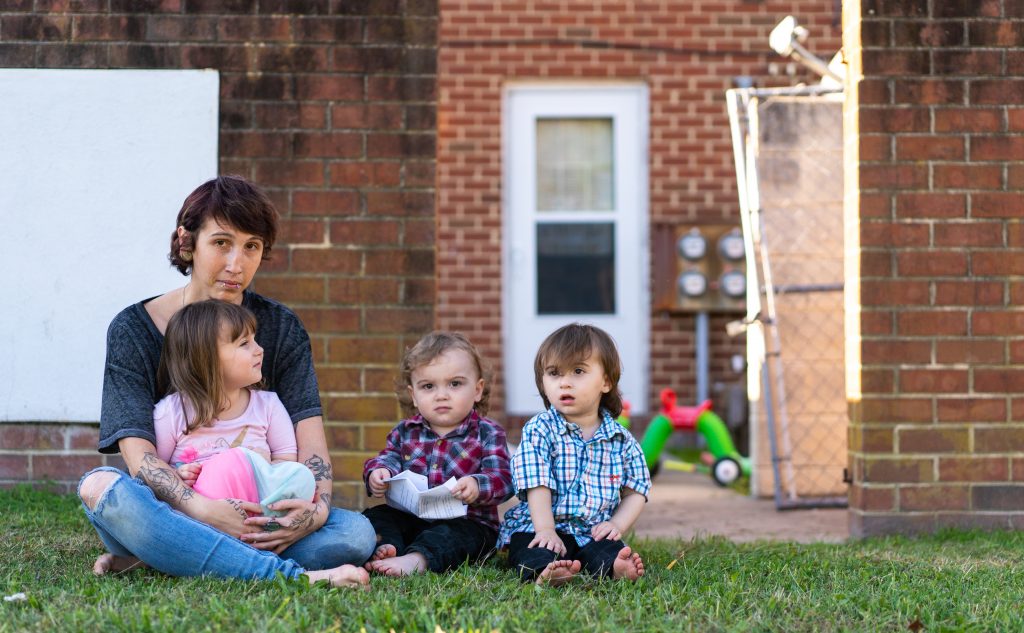
In late October, the housing authority filed another eviction case against her. The hearing was postponed to January after a rise in COVID-19 cases prompted Maryland courts to restrict operations again.
Amid the stress, Norris strived to make the holidays merry for her children. Recent videos of her home showed a living room decked out with Christmas lights and shimmery garlands, and toys strewn about.
“I struggle, but I’m finally on my feet,” she said. But each eviction notice triggers a new wave of panic and anxiety about losing her home and her kids.
“I’m constantly looking at the door, ‘Oh God, is there another, gonna be another sheriff to give me another thing?’ … It’s always a constant thing in the back of my head. I can’t get comfortable here.”


